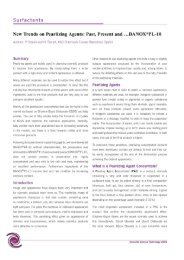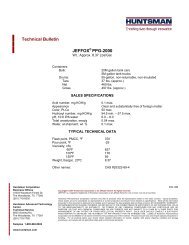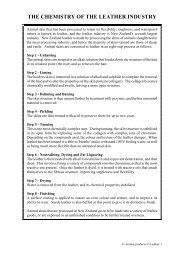BASF defoaming explanaiton
Create successful ePaper yourself
Turn your PDF publications into a flip-book with our unique Google optimized e-Paper software.
Defoamers act mainly in the stabilized lamella. Therefore<br />
they must be insoluble in the paint system, mobile so that<br />
they can enter in the lamella and spread at the interface<br />
to displace the surfactants. Defoamers must have a lower<br />
surface tension than the surfactant, leading to an opposite<br />
Marangoni effect, i.e. fast thinning and collapse of the<br />
lamella.<br />
Choosing a defoamer<br />
Possible chemical entities for defoamers are molecules<br />
with a low surface tension such as silicone and mineral<br />
oils, fatty acid and fluorocarbons. To increase the<br />
<strong>defoaming</strong> efficiency, solid particles with a low surface<br />
tension can be included, such as hydrophobic silica and<br />
metallic soaps. These materials can be incorporated in<br />
carriers such as water or organic solvents to promote<br />
addition and enable faster distribution of the active<br />
substance in the liquid paint. 100 % active defoamers are<br />
suitable for systems subjected to shear stresses<br />
such as grinding, ensuring their distribution and activity<br />
as a defoamer.<br />
Different defoamers for different systems<br />
For solvent-borne and solvent-free systems<br />
polysiloxanes, polyacrylates and polyolefins are effective,<br />
because these types of systems already have a low surface<br />
tension. Pure polydimethylsiloxanes can also be used but<br />
are critical in terms of their compatibility due to side-effects<br />
such as cratering. The best balance between compatibility<br />
and incompatibility is achieved through organically-modified<br />
polysiloxanes. Modification with fluorine gives even lower<br />
surface tensions.<br />
For water-borne systems a wider range of chemical<br />
structures can be used due to the generally higher surface<br />
tension of these systems; here mineral oil types and<br />
silicones are highly effective.<br />
An important point to consider is the incorporation of<br />
the defoamer in the paint system. The defoamer is not<br />
soluble in the system, so a good distribution of the active<br />
substance is necessary. This should be controlled by the<br />
mixing speed and time, otherwise craters can be formed<br />
and/or loss of <strong>defoaming</strong> efficiency is observed.<br />
Without and<br />
with defoamer<br />
04 05











![[Ulwick_A.W.]_Business_Strategy_Formulation_Theor(BookZZ.org)](https://img.yumpu.com/56355932/1/190x240/ulwick-aw-business-strategy-formulation-theorbookzzorg.jpg?quality=85)



![Desmond Morris - 2002 - Peoplewatching - The Desmond Morris Guide to Body Language (poor quality-double page)(290p) [Inua]](https://img.yumpu.com/54998318/1/189x260/desmond-morris-2002-peoplewatching-the-desmond-morris-guide-to-body-language-poor-quality-double-page290p-inua.jpg?quality=85)
